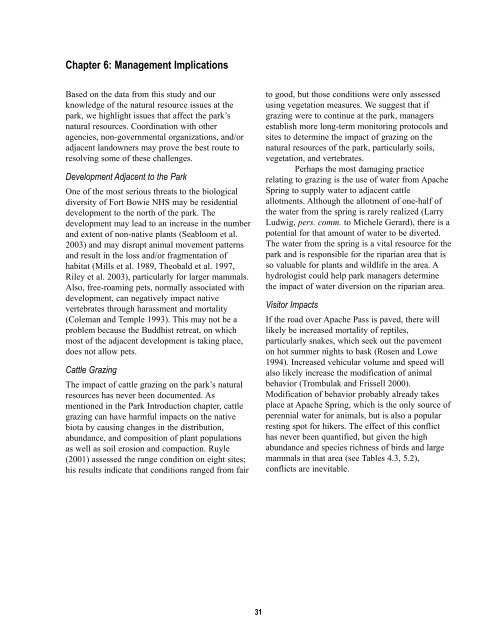Download this report as a 94-page PDF - USGS
Download this report as a 94-page PDF - USGS
Download this report as a 94-page PDF - USGS
Create successful ePaper yourself
Turn your PDF publications into a flip-book with our unique Google optimized e-Paper software.
Chapter 6: Management Implications<br />
B<strong>as</strong>ed on the data from <strong>this</strong> study and our<br />
knowledge of the natural resource issues at the<br />
park, we highlight issues that affect the park’s<br />
natural resources. Coordination with other<br />
agencies, non-governmental organizations, and/or<br />
adjacent landowners may prove the best route to<br />
resolving some of these challenges.<br />
Development Adjacent to the Park<br />
One of the most serious threats to the biological<br />
diversity of Fort Bowie NHS may be residential<br />
development to the north of the park. The<br />
development may lead to an incre<strong>as</strong>e in the number<br />
and extent of non-native plants (Seabloom et al.<br />
2003) and may disrupt animal movement patterns<br />
and result in the loss and/or fragmentation of<br />
habitat (Mills et al. 1989, Theobald et al. 1997,<br />
Riley et al. 2003), particularly for larger mammals.<br />
Also, free-roaming pets, normally <strong>as</strong>sociated with<br />
development, can negatively impact native<br />
vertebrates through har<strong>as</strong>sment and mortality<br />
(Coleman and Temple 1993). This may not be a<br />
problem because the Buddhist retreat, on which<br />
most of the adjacent development is taking place,<br />
does not allow pets.<br />
Cattle Grazing<br />
The impact of cattle grazing on the park’s natural<br />
resources h<strong>as</strong> never been documented. As<br />
mentioned in the Park Introduction chapter, cattle<br />
grazing can have harmful impacts on the native<br />
biota by causing changes in the distribution,<br />
abundance, and composition of plant populations<br />
<strong>as</strong> well <strong>as</strong> soil erosion and compaction. Ruyle<br />
(2001) <strong>as</strong>sessed the range condition on eight sites;<br />
his results indicate that conditions ranged from fair<br />
31<br />
to good, but those conditions were only <strong>as</strong>sessed<br />
using vegetation me<strong>as</strong>ures. We suggest that if<br />
grazing were to continue at the park, managers<br />
establish more long-term monitoring protocols and<br />
sites to determine the impact of grazing on the<br />
natural resources of the park, particularly soils,<br />
vegetation, and vertebrates.<br />
Perhaps the most damaging practice<br />
relating to grazing is the use of water from Apache<br />
Spring to supply water to adjacent cattle<br />
allotments. Although the allotment of one-half of<br />
the water from the spring is rarely realized (Larry<br />
Ludwig, pers. comm. to Michele Gerard), there is a<br />
potential for that amount of water to be diverted.<br />
The water from the spring is a vital resource for the<br />
park and is responsible for the riparian area that is<br />
so valuable for plants and wildlife in the area. A<br />
hydrologist could help park managers determine<br />
the impact of water diversion on the riparian area.<br />
Visitor Impacts<br />
If the road over Apache P<strong>as</strong>s is paved, there will<br />
likely be incre<strong>as</strong>ed mortality of reptiles,<br />
particularly snakes, which seek out the pavement<br />
on hot summer nights to b<strong>as</strong>k (Rosen and Lowe<br />
19<strong>94</strong>). Incre<strong>as</strong>ed vehicular volume and speed will<br />
also likely incre<strong>as</strong>e the modification of animal<br />
behavior (Trombulak and Frissell 2000).<br />
Modification of behavior probably already takes<br />
place at Apache Spring, which is the only source of<br />
perennial water for animals, but is also a popular<br />
resting spot for hikers. The effect of <strong>this</strong> conflict<br />
h<strong>as</strong> never been quantified, but given the high<br />
abundance and species richness of birds and large<br />
mammals in that area (see Tables 4.3, 5.2),<br />
conflicts are inevitable.

















